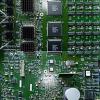> I first flashed the Pico with the firmware with the drag & drop method and then tried to get the config
> via the command line but it couldn't find the Pico. Very likely this is the WinUsb issue you were afraid of.
Yeah, looks like it - actually looks like it's failing even before getting to the WinUsb stage, just in the basic USB device management subsystem. Unfortunate but not surprising; Wine isn't really meant to be a complete Win32 emulation as far as I've seen, more for running GUI programs than fully emulating the whole sprawling Windows kernel.
> It looks like the code supports both the RP2040 and the RP2350 depending on which SDK is installed.
> Is there a reason to prefer one over the other?
For the moment I'd stick with RP2040, because I haven't attempted to build or test on RP2350. I tried to lay some groundwork where I'm aware of differences, but I expect there's more that will need to be done that will turn up the first time someone tries to actually build with an RP2350 target. The devices are MOSTLY similar, but they did make a few significant hardware changes that will probably require some more code adjustments. Longer term I'd definitely like to get the RP2350 going, just because it's the newer device and probably has a longer production horizon. I don't think it'll make too much difference feature-wise or performance-wise, though. The RP2350 "Pico 2" doesn't have any more exposed GPIO ports than the original, which is probably the biggest limit I'd like to see eased in a future generation. The CPU itself does have extra GPIOs, though, so maybe they'll come up with a Pico 2-1/2 at some point that adds pads for them.
By the way, I'm pretty sure they merged support for both boards into the one SDK. I think it's just a matter of selecting the target board in your build configuration. The SDK also supports a bunch of third-party Pico clones that you can target the same way.
> Are the builds on Github specific to one device or do they work on both?
RP2040 only, as far as I know. I think the RP2350 has a somewhat different image layout that requires a separate build.
> Your readme mentions that the Socketed Pico version of the DIY boards are the ones development will
> go forward in, so moving the others to a "deprecated" folder or something would be nice.
Yeah, you're right, I should make that more apparent in the file structure.
> I was also going to suggest putting the Gerbers and Drill files in the repo for people like me that don't
> use Eagle. But it appears the process is somewhat fab specific so scratch that.
That is precisely the reason. I need to look into automating the Gerber generation process - if I can make that happen, I can have my release scripts generate Gerbers for a few top vendors and add new ones as needed. As it is, it's a manual process, so they'd always be going out of date when I forget to update them; I figure everyone's happier if I just upload the "source files" (the EAGLE layouts) and let people generate the Gerbers on demand. It would be nice if Autodesk or someone else had an online Gerber generator so that you could run through the process without EAGLE installed, but I don't know of anything like that. OSH Park accepts the .BRD files directly, but almost no one else does that I've seen.
Edited by mjr, 07 February 2025 - 11:11 PM.






 Top
Top




















 are all trademarks of VPFORUMS.
are all trademarks of VPFORUMS.